I’m a veteran of the bag wars — balancing wants, needs, and cost across several categories of “go” gear. In the Air Force, I had a bug out bag (shoutout to Blackhawk, which I still have 10 years later!) that was always loaded up with a couple days worth of underclothing, sneakers, one change of weather- and mission-appropriate civilian clothing, first aid items, toiletries, snacks, a compressed sleeping bag and pad, a travel pillow, a lighter, a big-ass knife, a multitool, and my old Garmin eTrex (my M9 and spare mags were in my shoulder holster, and I’d already be wearing my uniform, boots, and sunglasses). My go bag went with me everywhere and came in handy dozens of times, whether getting that zero-dark-30 alert call, or if the jet broke down somewhere austere and I needed to shower and crash out for a couple of hours.
My world changed in 2011 when I ETS’d and joined the ranks of DD214-waving civilians. The go bag stayed packed, but I had to start packing new versions, starting with my GI Bill kit. I commuted to school on a bicycle and needed the same stuff every day — a laptop, some headphones, a notebook, a school book or two, and a stash of writing implements. I grew used to open-style bags that had one large compartment and maybe a small interior pocket. I ended up with a Chrome messenger bag that I love and still use. My laptop has a sleeve, and I have a nice little zippered pen pouch to keep everything separated and easy to find within the bag.
Editor’s note: the GPS Tactical Range Backpack also made Task & Purpose’s roundup of the best tactical backpacks of the year.
As I transitioned from studying photojournalism to working as a photographer, I started looking for the perfect camera bag. You might already know this, but there is no such thing as the “perfect” camera bag. I knew what I liked and didn’t like, but found that I needed three separate bags to lug gear around depending on the type of shoot and equipment I needed at the time. Range bags and tactical bags are really similar to camera bags in that everyone’s preferred loadout is a little different.
Then there’s my range bag. I’m mostly a pistol guy and like to shoot them all at least monthly to stay current, proficient, and safe on them. I have three handguns with a fourth on the way and desperately needed to upgrade my range bag situation. Until now, I’d been using a Blackhawk Sportster Deluxe, which was (and is) great for two pistols and ammo for both with a side of safety gear. I’ve seriously outgrown it now and needed a better solution to carrying around my growing collection.
With all of my experience working my way through go bags, camera bags, and school bags, I started looking into new range bag options hoping to land on a good one. With the GPS Tactical Range Backpack, I wasn’t disappointed.
Unboxing
I immediately loved the GPS Tactical Range Backpack. It shipped in a ridiculously large box, the kind that kids and small animals love to play in, and inside the box was an FDE backpack wrapped in plastic. At first touch, the GPS Tactical Range Backpack felt like a quality piece of kit. It’s made from 1000 Denier polyester. Denier is a measurement of thickness for individual strands of woven fabrics. One Denier is based on one strand of silk, so 1000 Denier is going to be the equivalent of 1000 strands of silk. The two most common 1000 Denier materials are polyamides (the trade name is Nylon) and polyester. They each have advantages, but they are use-dependent. In a range bag, either would work. The advantages of using polyester in GPS range bags is that polyester doesn’t hold water or stretch the way wet Nylon does, so the bag holds its shape better in the rain.
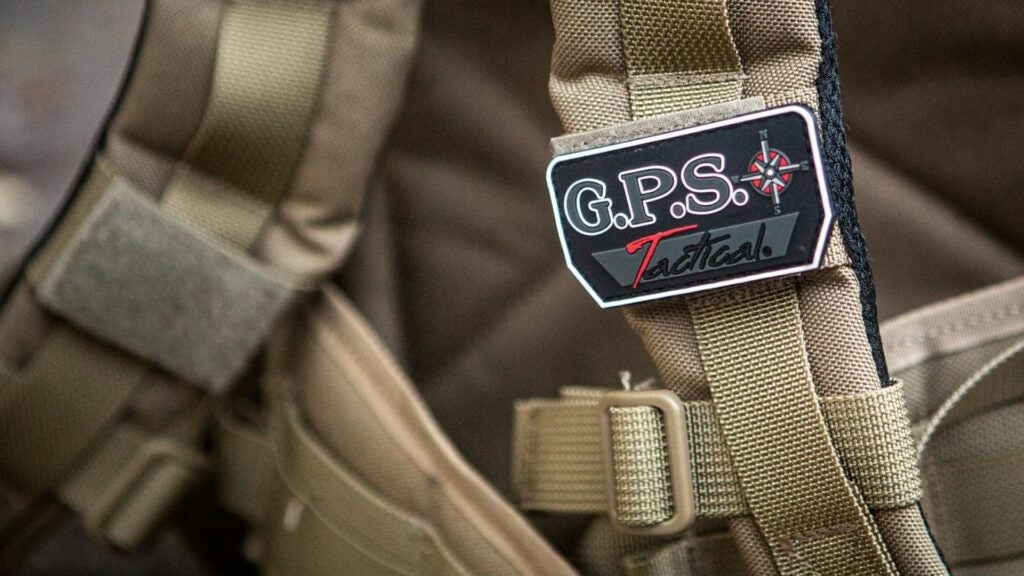
The second advantage that polyester has over Nylon here is abrasion resistance. If you’re like me, you’re throwing your range bag down on rough concrete, or gravel, or floors with grip tape or bedliner applied. A polyester bag will last a bit longer than a Nylon bag in those environments. The last advantage is one you’re probably familiar with — 550 cord is Nylon and if you’re like me, you’ve burned off or melted ends of 550 to keep it from fraying, and you know that Nylon gets really soft at temperatures that you can still touch with your bare hands. Polyester is much less sensitive to heat, so if you leave your bag in a hot car, you don’t have to worry about it losing its shape.
GPS Tactical’s Range Backpack uses that 1000D polyester for those reasons and then takes it a step further by coating the fibers in Teflon to keep your expensive range backpack from taking a bunch of stains from lead, cordite, or CLP. The pack also has a great little rain cover that is easy to use so you can take it to outdoor ranges even on bad-weather days.
One of the things that impressed me right out of the box were the zippers. They’re YKK branded, have 550 cord pulls, and the pistol compartment zippers have provisions for a lock. That’s not the only thing that yells “quality” at you when you hold it, though. Everything is double- or triple-stitched with embroidered hold-downs on critical areas, just like on parachute straps or seat harnesses. GPS Tactical did a great job making this backpack sturdy for what I put it through.
The last thing that got me right out of the box were the pocket labels. Each of the zippered areas has a sewn label, both inside and out, with little logos of what’s supposed to be in the pocket. That was a wonderful little surprise and I got a kick out of putting my gear into those pockets, knowing that I wouldn’t have to search through the pockets of a new bag because I forgot where I tucked a knick-knack away.
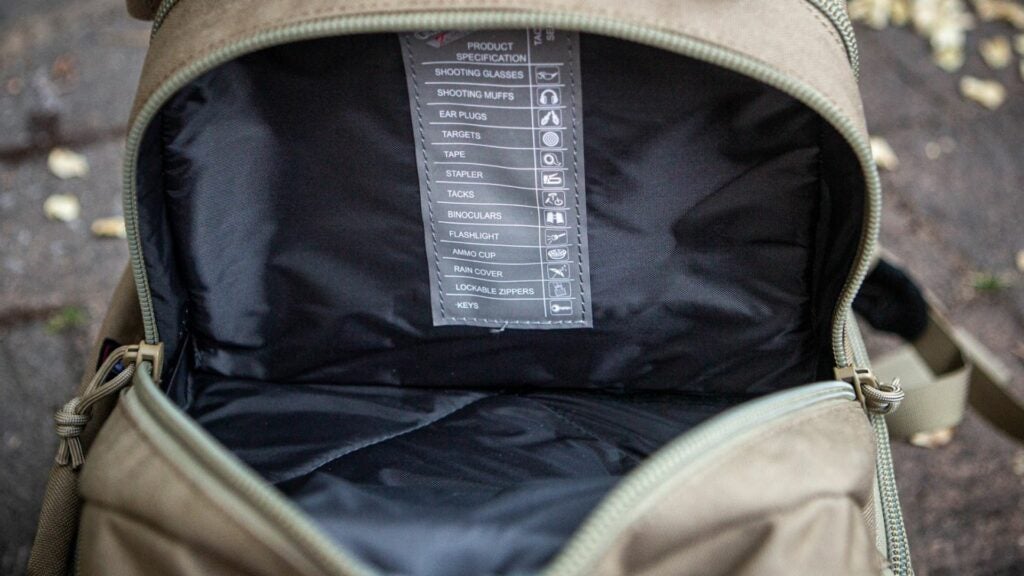
How we tested the GPS Tactical Range Backpack
There’s really only one way to test a bag like the GPS Tactical Range Backpack, and that’s to stuff it full of gear and put it to work. That’s exactly what I did. I dumped everything out of my sad, overflowing range duffel and put it in my new backpack piece by piece into the labeled pockets. Once I had it loaded up, I put it on and adjusted all of the straps and climbed up and down my stairs to see if it would work running around in the woods. It was comfortable, but the sizing didn’t quite work with my 6-foot 3-inch frame. If I had the shoulder straps adjusted so that the pack was in the right spot on my back, then the waist strap fell around my belly button.
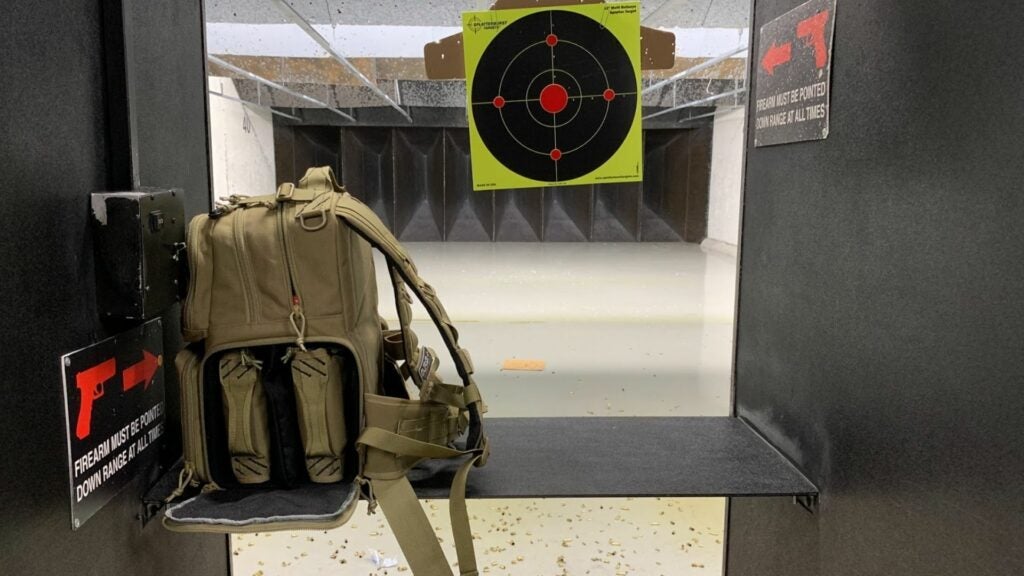
Loading up was easy and fast, but I ran into a snag with the three included pistol cases. The cases are a little small. If you have mostly compacts or single-stack pistols, you won’t have issues.
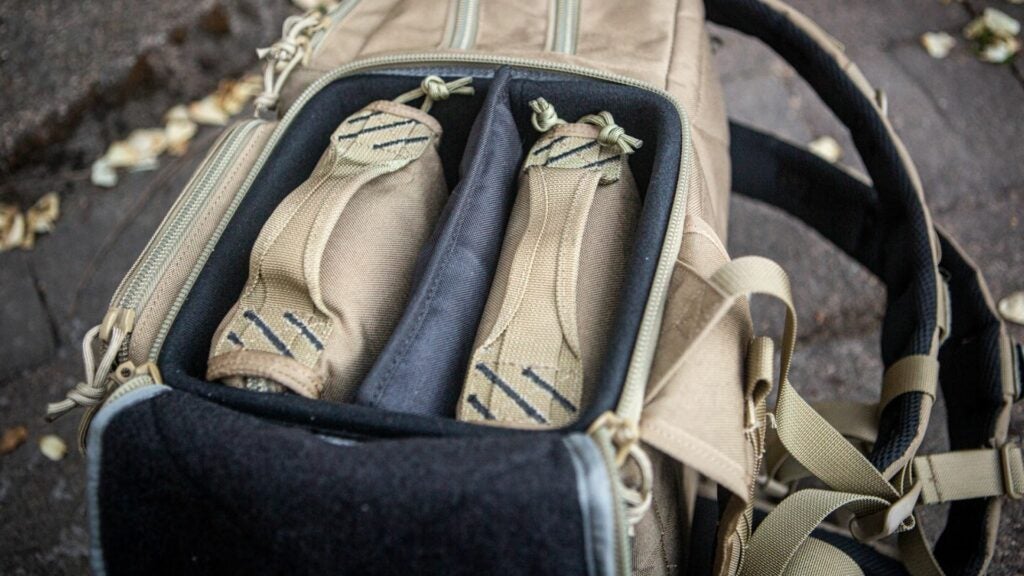
The snag I found was kind of hilarious because I was most worried about my CZ TSO and wasn’t thinking about my Ruger MK4 Lite at all. My VP40 fit in the case a little tight but wasn’t a hassle. The mags fit in the pouches, and the case closed just fine.

Next up came the TSO, which fit just fine with some finesse, along with three mags. It was the little .22 that wound up being the problem. Mine is kitted out with most of the Tandemkross catalog, and wasn’t even close to fitting. It has a compensator, a big grip, a gas pedal, a charging halo, and a Holosun 507C on the pic rail. The Ruger was already in a sleeve though, so I just tucked the sleeve between two of the cases, zipped it up, and called it good.
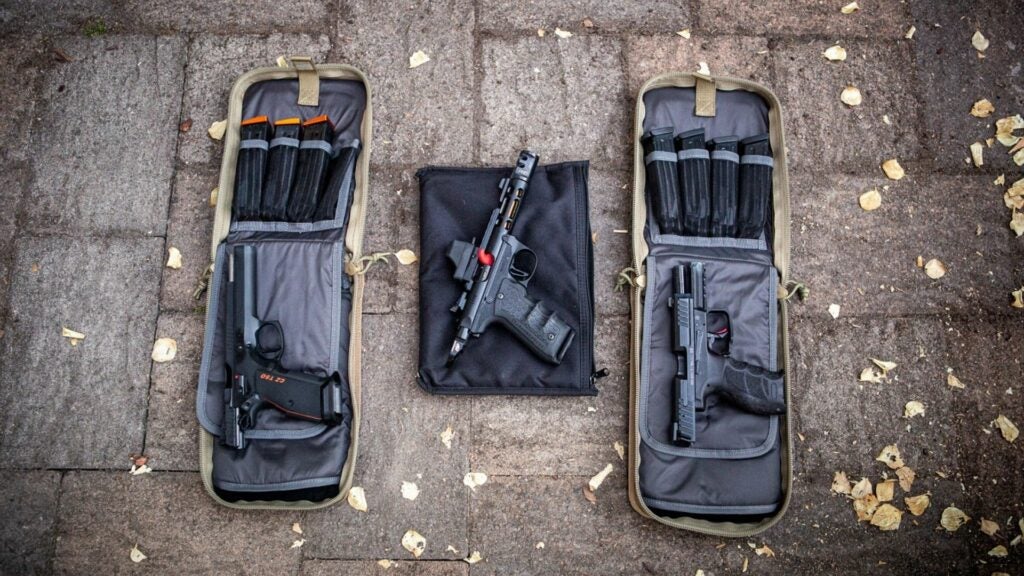
After adjusting everything and loading up, it was time to hit the range and see what it’s like digging through the pack.
What we like about the GPS Tactical Range Backpack
The biggest and probably most obvious benefit to the GPS Tactical Range Backpack is that both of your hands are free when you’re signing in to your range without putting the bag down. Second, this backpack has a dedicated ammo compartment. If your range does ammo checks like mine does, having that pocket is awesome. I had to stack my ammo boxes wherever they fit in my old bag, so I wound up having to dig around for my ammo. It also meant that I’d be going past my pistol sleeves and you know the RSO always wants to take a look. I’m not a fan of people using their authority to touch my stuff, so that bugged me. The GPS Tactical Range Backpack keeps my pistols out of sight and out of mind while checking in.
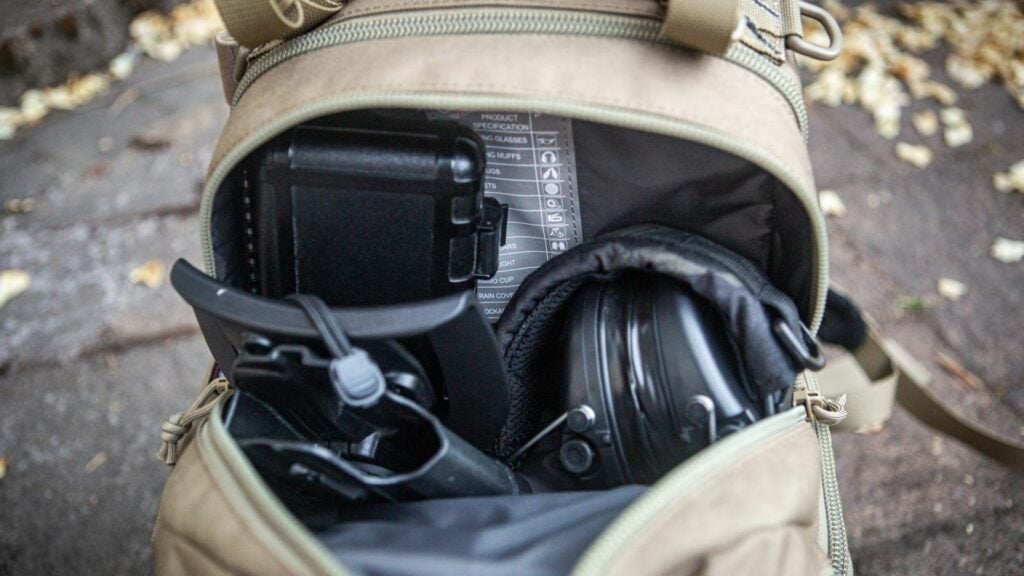
The dedicated ammo pocket is cool, but there are individually labeled pouches for eye pro, ear pro, tools, small parts, and everything else you need on a solo range day. I found that my holster, Sordins, custom ear pro case, and shooting ball cap fit in the middle pocket between the accessories pouch and ammo compartment perfectly. The accessory pouch has an individual labeled and padded pouch for eye pro and another labeled pouch for ear plugs. Below that, the front pouch flaps down to create a small work surface and has space for a couple of spare mags, tools, and a small plastic case for tune up and spare parts.
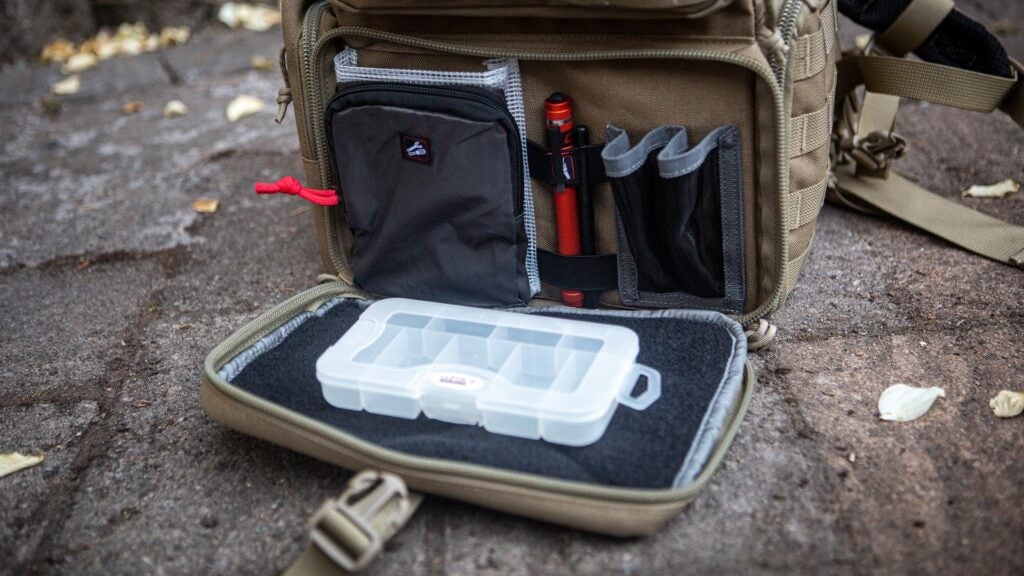
GPS Tactical knocked it out of the park with this range backpack. I had three types of ammo in the bag, and it held more than I really wanted to shoot in one day. It held 200 rounds of 9mm, 100 of .40 S&W, and 500 of .22, and there was still room for more. It held three pistols, all of which were easy to access. I didn’t have to fight or dig around for my ears and eyes, and I got to just sling it over my back and walk out when I was done.
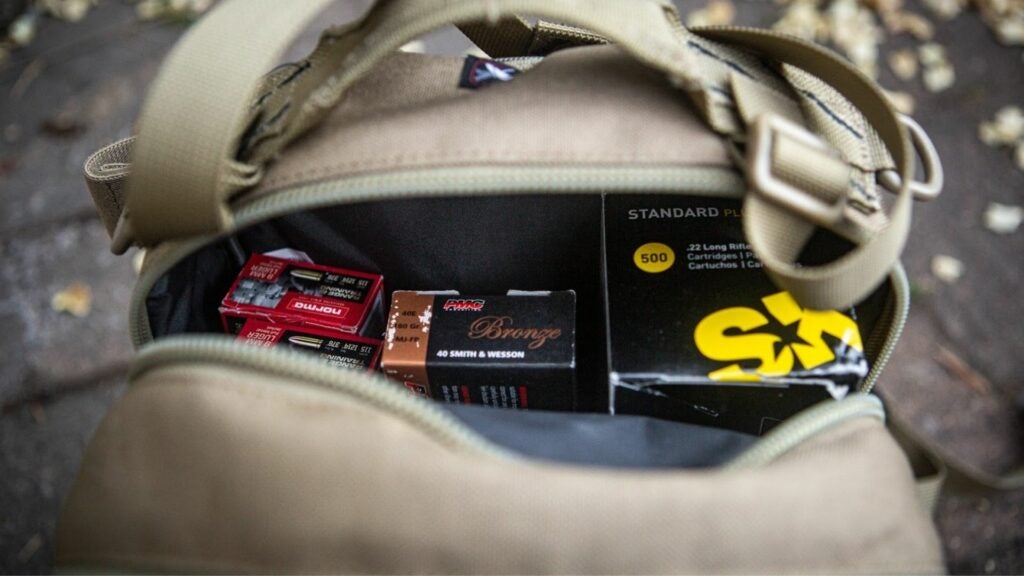
What we don’t like about the GPS Tactical Range Backpack
There wasn’t a lot to dislike about this range backpack. My issues were mostly minor. The biggest gripe for me is the size of the pack. Because the pack is compact, it’s not tall enough for the waist straps and shoulder straps to be both in the right place and at the right time for me. It’s important because I have back problems like a lot of veterans and range bags can get pretty heavy.
I had a minor issue with the size of the included pistol cases because there’s no reason they can’t be an inch larger in every dimension. That’s all it would take for the pistol cases to comfortably fit just about any pistol. Obviously, if a TSO fits (barely), then you’re not going to have issues with a 1911 or an M&P 2.0, but the fact that my .22 doesn’t fit in those cases isn’t great.
Some even more minor gripes: The pistol cases don’t have a provision for labels along their spines, so you’re not sure which pistol you’re pulling out. Even some Velcro stitched on to the spine would be enough to fix it, just so I could tell which case is which. An embroidered stripe on one of them would do wonders there.
Last, and probably most minor, the ear pro labeled pocket is just for ear plugs, and there’s no real provision for full sized muffs like my MSA Sordins. I got around the issue really easily, but it seems like a glaring oversight by GPS Tactical because of how good the rest of this pack is.
Verdict
Like I shared at the beginning of this review, there’s no such thing as a perfect range bag. Even a bag as great as the GPS Tactical Range Backpack has small faults. That said, it’s the best range bag I’ve used by a wide margin.
As I write this, the pack is $140 on Amazon, and it’s worth every penny. I’ve been extremely impressed with the quality of the design, the usefulness, and the convenience it offers for lugging three pistols worth of gear around. While I can imagine features I’d like, I haven’t found another range bag that even comes close to the GPS Tactical Range Backpack. I can’t imagine going back to my old range duffle.
FAQs about the GPS Tactical Range Backpack
Q. How much does the GPS Tactical Range Backpack cost?
A. At the time of publication, the GPS Tactical Range Backpack in FDE costs around $155 shipped.
Q. Who makes GPS Tactical’s range bags?
A. GPS Tactical is a subsidiary of Go Outdoors, an outdoor enthusiast gear company founded in 2002. Go Outdoors has several other brands of gear.
Q. How many pistols will the GPS Tactical Range Backpack hold?
A. This backpack will hold three pistols in the included cases, or as many as five if you use your own pistol sleeves and jam them in there. GPS Tactical also has a “Tall” version of this backpack that comes with four sleeves, but is very similar otherwise.
We’re here to be expert operators in everything How-To related. Use us, compliment us, tell us we’ve gone full FUBAR. Comment below and let’s talk! You can also shout at us on Twitter or Instagram.
Task & Purpose and its partners may earn a commission if you purchase a product through one of our links. Learn more about our product review process.
